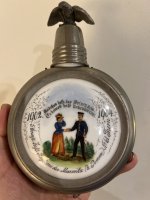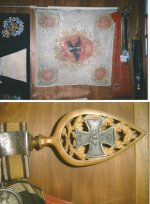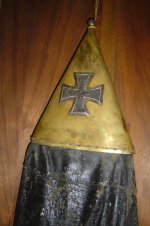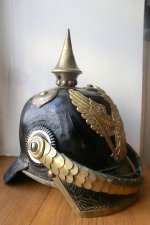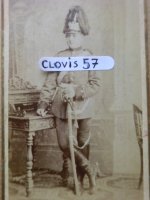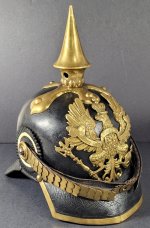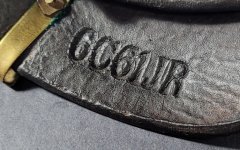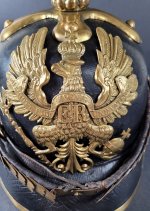Happy Father's Day Guys.....I've been working on this little essay for a while and thought I'd post it, I hope you enjoy it.
This very sound and complete example of an issue M1860 Infantry pickelhaube is issue marked to the 9th Company (III, Fusilier Battalion) 8.Pommersches Infanterie-Regiment von der Marwitz Nr 61. The 61st was formed in May of 1860, with it’s battalions being garrisoned in the fortress town of Thorn (Polish Torun) situated on the right bank of the Vistula River in what is now Western Poland.
During the War of 1870-1871 the 61st Regiment served with the II Corps, initially forming part of the Field Army under the command of General of Cavalry Baron von Manteuffel.

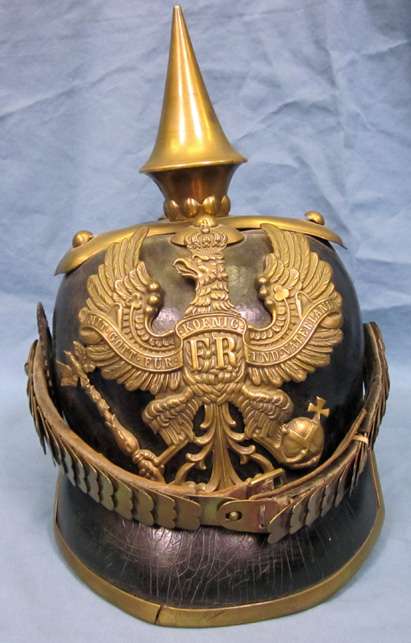
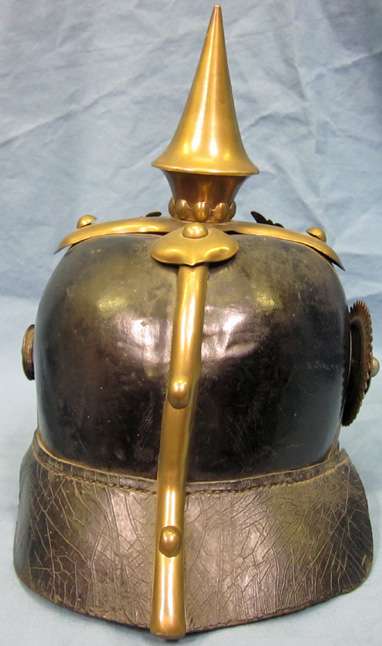
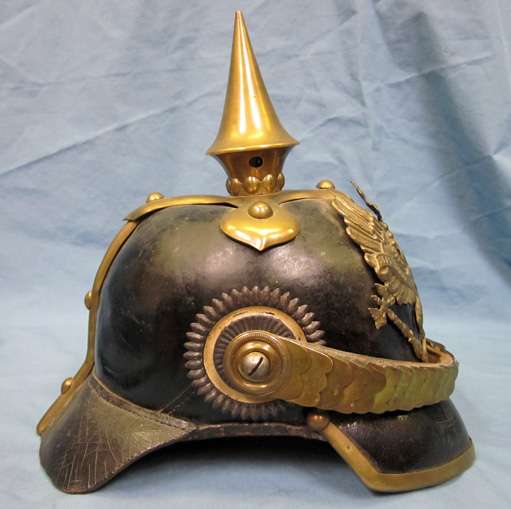
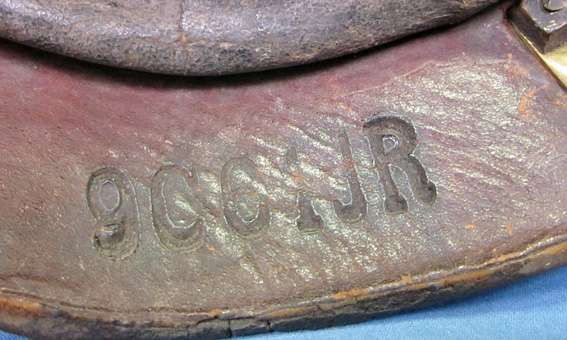
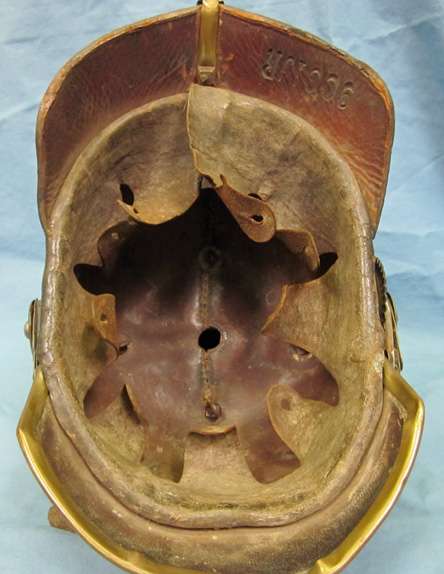
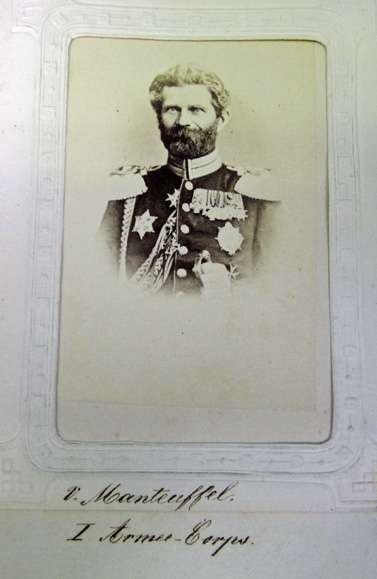
The 61st was assigned to the 4th Infantry Division commanded by Lieutenant-General Hann v.Weihern, 8th Infantry Brigade under Major-General von Kettler and was itself commanded by Colonel v.Wedell.
On the 16th of August 1870 the II Corps was assigned to the II Army under the command of HRH Prince Frederick-Charles of Prussia. Shown here while serving during the 1864 War with Denmark. Note the cannonball he is resting his right foot on. Under his command the 61st participated in the following engagements.
8/18/1870 Gravelotte-St.Privat, 1 Soldier killed, 2 Officers wounded, 14 Soldiers wounded
8/19/1870 Beginning of the Siege of Metz. 1 Officer Killed, 2 Soldiers wounded
10/4/1870 1 Soldier wounded
10/6/1870 1 Soldier wounded
10/8/1870 1 Soldier killed, 2 Soldiers wounded, 2 Soldiers missing
10/27/1870 Metz Surrenders
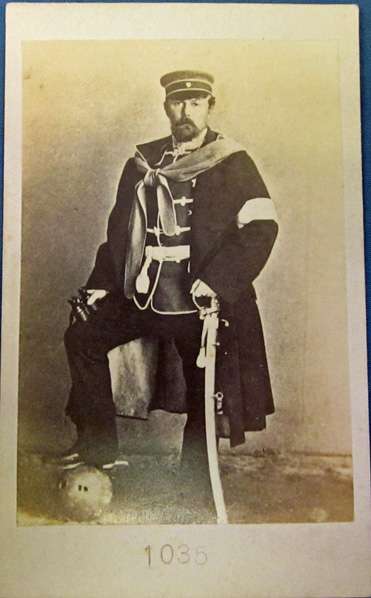
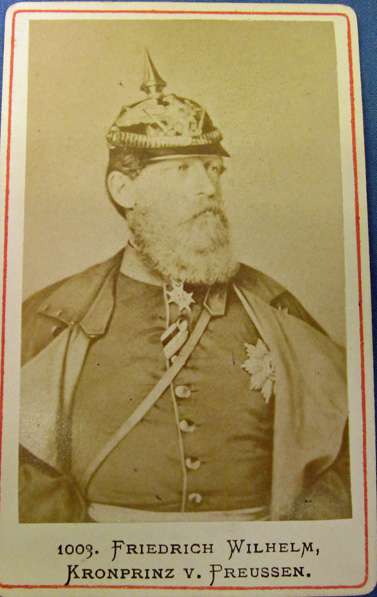
Assigned to the III Army under the command of HRH Field-Marshall Friedrich-Wilhelm, Crown Prince of Prussia.
Siege of Paris, November 1870
12/5/1870 1 Soldier wounded
1/11/1871 Assigned to the South Army, again under the command of General Baron von Manteuffel
1/21/1871 Engagements at Talent, Fontaine les-Dijons, and Messigny. 5 Officers killed, 55 Soldiers Killed, 3 Horses Killed. 8 Officers wounded, 156 Soldiers wounded
1/22/1871 3 Soldiers killed, 1 Officer wounded, 9 Soldiers wounded, 6 Soldiers missing
1/23/1871 Engagement at Pouilly 2 Officers killed, 41 Soldiers killed, 1 Horse killed, 7 Officers wounded, 138 Soldiers wounded, 11 Soldiers missing. The second battalion lost its color in this engagement
1/28/1871 17 Soldiers killed, 5 Officers wounded, 60 Soldiers wounded
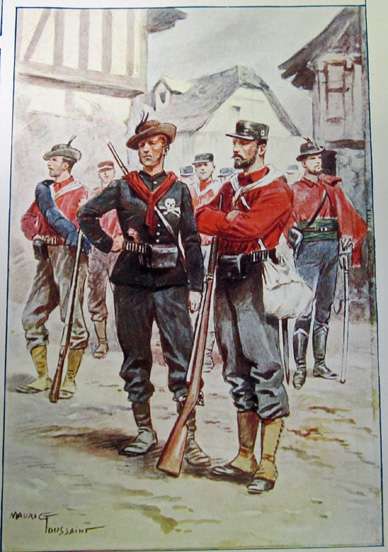
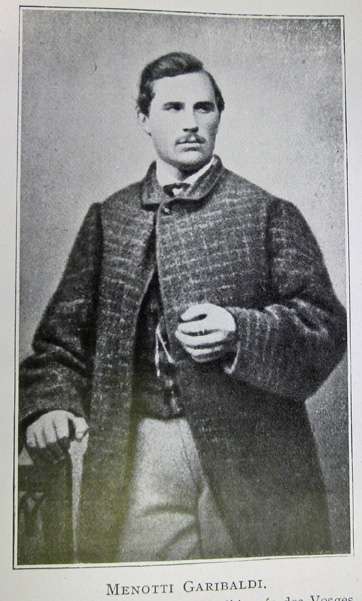
Perhaps the most interesting incident concerning this regiments service during the War of 1870-71, is the 61st Regiment holds the unhappy distinction of being the only German regiment to lose a color to the enemy during that war. To be exact, the loss occurred to the 2nd Battalion during the Battle of Dijon-Pouilly on the 23rd of January 1871.
The loss of their color was of potential great shame for this battalion and regiment, so much so that Crown Prince Friedrich Wilhelm made mention of it in his war diary. He writes “this disaster will ever be an open wound for the unfortunate regiment, the more painful as Garibaldian levies were their opponents”. However, on the 12th of February 1871 additional information was provided the Prince which changed his opinion completely. An intercepted letter written to the French authorities by Menotti Garibaldi (son of Giuseppe and commander of the units which opposed the 61st), describes how after the fight at Dijon, in which the colors of the 2nd Battalion of the 61st regiment disappeared, the flag was found under a heap of corpses and drenched with blood. The Crown Prince after reading the captured letter then wrote the following entry in his diary, “Could our officers and soldiers have done their duty more nobly or more gallantly guarded the honor of the flag? I find the deed so moving that I feel like weeping every time I think of it“.
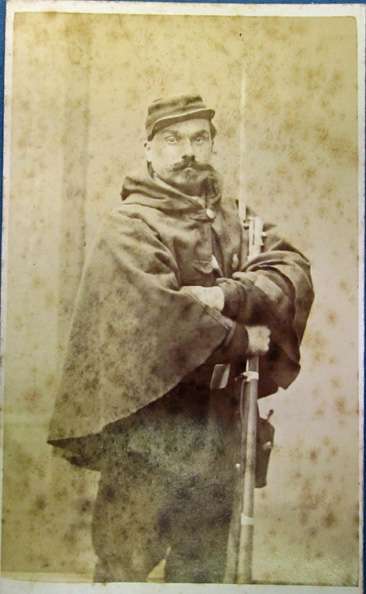
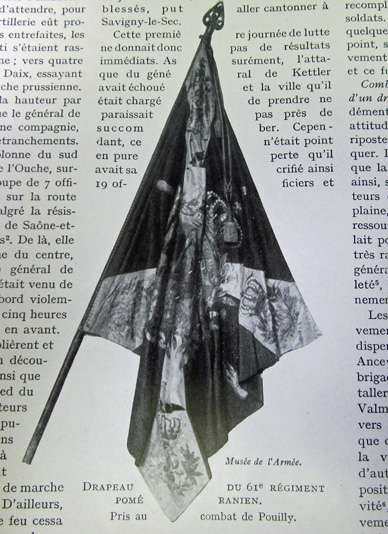
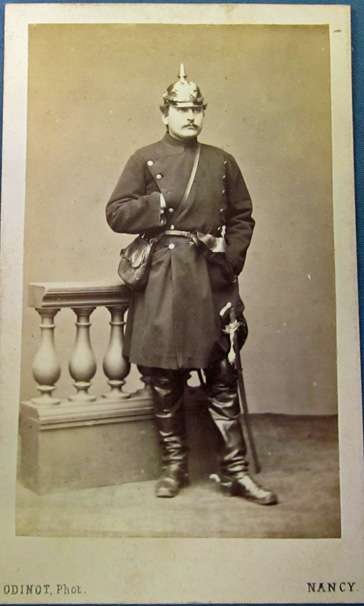
The official German account of this action may be found in Volume 4, pages 22-23 of the German General Staff Report. It reads as follows; ENGAGEMENT AT POUILLY ON 23RD JANUARY. “…A heavy fire was now directed upon the 61st. The commander of the 2nd Battalion, Captain Kumme, as also the commander of the 6th Company, Lieutenant Straube, were speedily placed “hors de combat” from wounds . 1st Lieutenant Luchs (also wounded and his horse killed) assumed the command of the battalion. The 7th Company was reduced to some 70 bayonets, and the 5th Company, brought up from the reserve, was still to a certain extent intact; the evening was closing in, fog and powder smoke concealed the view; the enemy, as the firing showed, was receiving reinforcements. In spite of that, Lieutenant Luchs decided to renew the attack. Whilst maintaining his front towards St.Martin with the 6th and 7th Companies in order to guard against a hostile attack from that direction, he ordered 1st Lieutenant Weise with the 5th Company to advance once more against the factory. This officer, after explaining to his company the task they had before them led the way into the shower of bullets. By his side, carrying the color of the battalion, was Sergeant Pionke, who fell dead before he had proceeded many yards. Lieutenant Weise, also wounded, had to be carried to the rear. As the edge of the excavation was steeply scarped in the direction of the attack, and at the time was very slippery, only some forty men were able to follow at first. 2nd Lieutenant Schulze, raising the color aloft led them forward, but likewise sank to the earth pierced by two bullets. Several musketeers who in succession bore the color met a glorious death, as also did the adjutant of the battalion, Lieutenant von Puttkamer, who pressing forward, fell immediately in front of the factory.
The fact that there was no entrance to the building on the west side could not be perceived from the excavation. The men, who in spite of the murderous fire, charged close up to it, could in consequence do nothing, and most of the them succumbed to the enemy’s fire. The Sergeant-Major of the company led back the few survivors to the excavation. Here for the first time the color was found to be missing, but in spite of the darkness and the continuous heavy fire, many volunteers went in search of it. But only one of them returned (Musketeer Schumacher), and he was wounded; the others lost their lives in the vain attempt. As the men fighting near Lieutenant von Puttkammer had all been killed, there was still doubt as to whether the last bearer of the color had not fallen in with another body of troops.
As a matter of fact, the only color which the Germans lost in this war was discovered by some men of Ricciotti Garibaldi’s brigade (it was this unit which had defended the factory) under a heap of dead bodies not far from the factory, riddled with bullets and steeped in blood”.
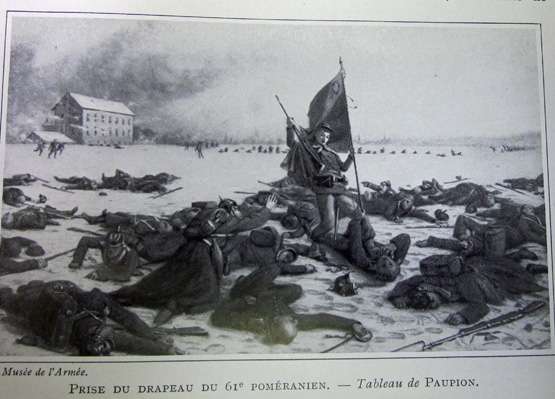
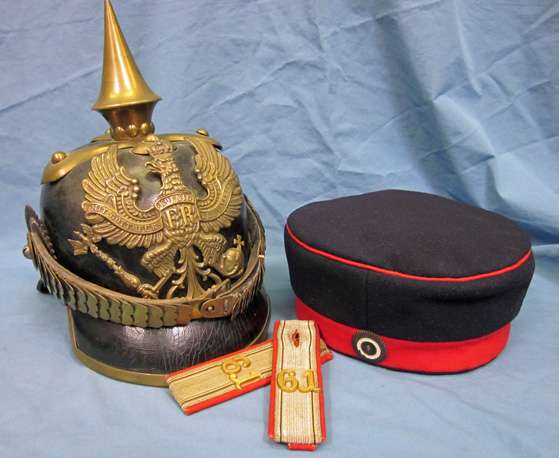
Sources:
The War Diary of the Emperor Frederick III 1870-1871, edited by A.R.Allinson
Histoire Generale de la Guerre Franco-Allemande 187-1871 by Lt. Colonel Rousset
German General Staff Report, The Franco-German War 1870-17, translated by Captain F.C.H.Clarke
Imperial German Headgear 188801914 Field Guide by James D. Turinetti and Jn. Albert O'Connor
This very sound and complete example of an issue M1860 Infantry pickelhaube is issue marked to the 9th Company (III, Fusilier Battalion) 8.Pommersches Infanterie-Regiment von der Marwitz Nr 61. The 61st was formed in May of 1860, with it’s battalions being garrisoned in the fortress town of Thorn (Polish Torun) situated on the right bank of the Vistula River in what is now Western Poland.
During the War of 1870-1871 the 61st Regiment served with the II Corps, initially forming part of the Field Army under the command of General of Cavalry Baron von Manteuffel.







The 61st was assigned to the 4th Infantry Division commanded by Lieutenant-General Hann v.Weihern, 8th Infantry Brigade under Major-General von Kettler and was itself commanded by Colonel v.Wedell.
On the 16th of August 1870 the II Corps was assigned to the II Army under the command of HRH Prince Frederick-Charles of Prussia. Shown here while serving during the 1864 War with Denmark. Note the cannonball he is resting his right foot on. Under his command the 61st participated in the following engagements.
8/18/1870 Gravelotte-St.Privat, 1 Soldier killed, 2 Officers wounded, 14 Soldiers wounded
8/19/1870 Beginning of the Siege of Metz. 1 Officer Killed, 2 Soldiers wounded
10/4/1870 1 Soldier wounded
10/6/1870 1 Soldier wounded
10/8/1870 1 Soldier killed, 2 Soldiers wounded, 2 Soldiers missing
10/27/1870 Metz Surrenders


Assigned to the III Army under the command of HRH Field-Marshall Friedrich-Wilhelm, Crown Prince of Prussia.
Siege of Paris, November 1870
12/5/1870 1 Soldier wounded
1/11/1871 Assigned to the South Army, again under the command of General Baron von Manteuffel
1/21/1871 Engagements at Talent, Fontaine les-Dijons, and Messigny. 5 Officers killed, 55 Soldiers Killed, 3 Horses Killed. 8 Officers wounded, 156 Soldiers wounded
1/22/1871 3 Soldiers killed, 1 Officer wounded, 9 Soldiers wounded, 6 Soldiers missing
1/23/1871 Engagement at Pouilly 2 Officers killed, 41 Soldiers killed, 1 Horse killed, 7 Officers wounded, 138 Soldiers wounded, 11 Soldiers missing. The second battalion lost its color in this engagement
1/28/1871 17 Soldiers killed, 5 Officers wounded, 60 Soldiers wounded


Perhaps the most interesting incident concerning this regiments service during the War of 1870-71, is the 61st Regiment holds the unhappy distinction of being the only German regiment to lose a color to the enemy during that war. To be exact, the loss occurred to the 2nd Battalion during the Battle of Dijon-Pouilly on the 23rd of January 1871.
The loss of their color was of potential great shame for this battalion and regiment, so much so that Crown Prince Friedrich Wilhelm made mention of it in his war diary. He writes “this disaster will ever be an open wound for the unfortunate regiment, the more painful as Garibaldian levies were their opponents”. However, on the 12th of February 1871 additional information was provided the Prince which changed his opinion completely. An intercepted letter written to the French authorities by Menotti Garibaldi (son of Giuseppe and commander of the units which opposed the 61st), describes how after the fight at Dijon, in which the colors of the 2nd Battalion of the 61st regiment disappeared, the flag was found under a heap of corpses and drenched with blood. The Crown Prince after reading the captured letter then wrote the following entry in his diary, “Could our officers and soldiers have done their duty more nobly or more gallantly guarded the honor of the flag? I find the deed so moving that I feel like weeping every time I think of it“.



The official German account of this action may be found in Volume 4, pages 22-23 of the German General Staff Report. It reads as follows; ENGAGEMENT AT POUILLY ON 23RD JANUARY. “…A heavy fire was now directed upon the 61st. The commander of the 2nd Battalion, Captain Kumme, as also the commander of the 6th Company, Lieutenant Straube, were speedily placed “hors de combat” from wounds . 1st Lieutenant Luchs (also wounded and his horse killed) assumed the command of the battalion. The 7th Company was reduced to some 70 bayonets, and the 5th Company, brought up from the reserve, was still to a certain extent intact; the evening was closing in, fog and powder smoke concealed the view; the enemy, as the firing showed, was receiving reinforcements. In spite of that, Lieutenant Luchs decided to renew the attack. Whilst maintaining his front towards St.Martin with the 6th and 7th Companies in order to guard against a hostile attack from that direction, he ordered 1st Lieutenant Weise with the 5th Company to advance once more against the factory. This officer, after explaining to his company the task they had before them led the way into the shower of bullets. By his side, carrying the color of the battalion, was Sergeant Pionke, who fell dead before he had proceeded many yards. Lieutenant Weise, also wounded, had to be carried to the rear. As the edge of the excavation was steeply scarped in the direction of the attack, and at the time was very slippery, only some forty men were able to follow at first. 2nd Lieutenant Schulze, raising the color aloft led them forward, but likewise sank to the earth pierced by two bullets. Several musketeers who in succession bore the color met a glorious death, as also did the adjutant of the battalion, Lieutenant von Puttkamer, who pressing forward, fell immediately in front of the factory.
The fact that there was no entrance to the building on the west side could not be perceived from the excavation. The men, who in spite of the murderous fire, charged close up to it, could in consequence do nothing, and most of the them succumbed to the enemy’s fire. The Sergeant-Major of the company led back the few survivors to the excavation. Here for the first time the color was found to be missing, but in spite of the darkness and the continuous heavy fire, many volunteers went in search of it. But only one of them returned (Musketeer Schumacher), and he was wounded; the others lost their lives in the vain attempt. As the men fighting near Lieutenant von Puttkammer had all been killed, there was still doubt as to whether the last bearer of the color had not fallen in with another body of troops.
As a matter of fact, the only color which the Germans lost in this war was discovered by some men of Ricciotti Garibaldi’s brigade (it was this unit which had defended the factory) under a heap of dead bodies not far from the factory, riddled with bullets and steeped in blood”.


Sources:
The War Diary of the Emperor Frederick III 1870-1871, edited by A.R.Allinson
Histoire Generale de la Guerre Franco-Allemande 187-1871 by Lt. Colonel Rousset
German General Staff Report, The Franco-German War 1870-17, translated by Captain F.C.H.Clarke
Imperial German Headgear 188801914 Field Guide by James D. Turinetti and Jn. Albert O'Connor

